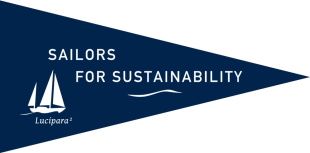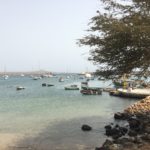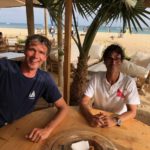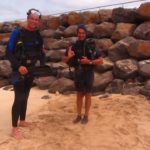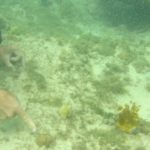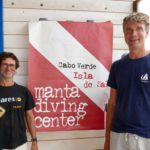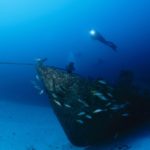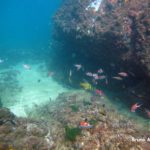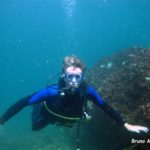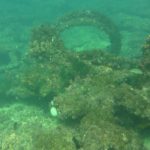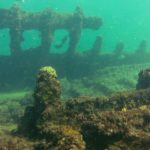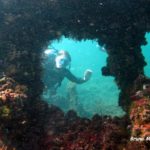Artificial Reefs (CPV)
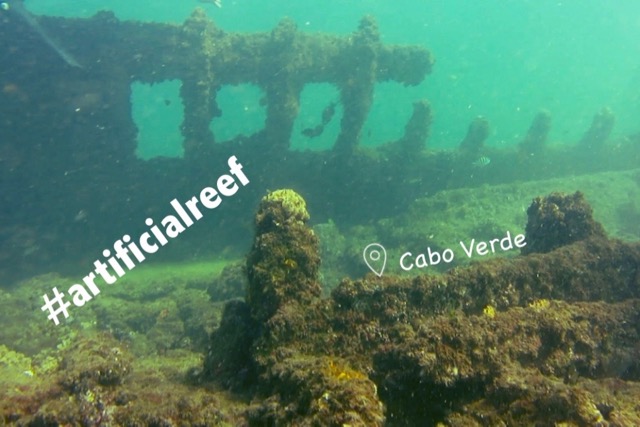
In Cape Verde and Brazil we learn how man-made structures can help to restore underwater ecosystems.
Contributes to achieving the following UN Sustainable Development Goals:
“This is the worst site to dive on the island”, Nuno says, tongue-in-cheek. “But it’s the best place to show you what I mean.” Equipped with diving gear, we follow Nuno into the sea. Underwater it looks like a desert. There are no fish in sight, no coral to brighten the bland beige around us. It isn’t until Nuno waves his hand above the sand that parts of the natural reef are revealed. Back on the beach Nuno explains: “The new hotel here had piers built to create a sandy beach. Those piers have changed the currents, leading to sand being deposited on the reef and killing the coral.” Nuno asserts that the place was full of life once, but that he still has hope. “With artificial reefs we can compensate for this loss” Nuno smiles.
From Dive Pioneer to Activist
Nuno Marques da Silva arrived as a young Portuguese diver at the Cape Verdian island of Sal over 30 years ago. He founded Manta Diving Center, the first diving school on the island. “The underwater world was dazzlingly rich and overwhelmingly productive”, he recalls vividly. “Wherever you looked, there were fish, turtles and corals. Very few humans were around and the water was crystal clear.” Nuno’s eyes shine brightly when he tells us about it, before his face turns serious. “Over the years, I have seen the ecosystem deteriorate enormously. As tourism grew, more and more hotels were built and pollution and fishing increased. Coral reefs have to endure more divers, who often damage them unintentionally.” It explains why marine life is only a fraction of what it used to be. Nuno laments the destruction and pressure on the reefs and decided to do something about it.
Inspiration from Japan
“I heard a story about Japanese fishermen”, Nuno starts. “They built underwater constructions made of bamboo, because there was little marine life on the sandy bottom of their bay. Soon, algae, seaweed and coral started to grow on the bamboo. Small fish found shelter there, which in turn attracted larger fish. The chain reaction in the ecosystem that the fishermen set in motion led to an increased fish stock in their bay.” With this example in mind, Nuno reviewed his option on Sal. “I saw an abandoned ship and realized that a shipwreck could also work as an artificial reef. If I managed to have it sunk, it would not only be good for the ecosystem, but could also provide a rich new dive site.”
From Ship to Reef
Our interest is ignited, but we are sceptic. “Surely you can’t just sink a ship just like that”, we ask Nuno. “What about the ship’s on-board equipment that may be toxic to marine life?” Nuno nods his head. “Of course we first had to remove all of it! Only then we sank the ship, in a controlled manner, at a depth that is safe for shipping.” It was a labour-intensive and exciting project, Nuno convinces us.
It didn’t take long to see results. “We were astonished by the pace at which nature took over the ship in the following weeks,” Nuno reflects. “Seaweeds and corals found a new home. All kinds of fish began to appear, attracted by the shelter that the wreck offers. Predatory fish followed them and soon a whole new ecosystem was created.” To measure the effect of the artificial reef on the underwater world, Nuno worked together with the University of Lisbon. “We marked fish and traced them. This enabled us to prove that new fish inhabited the wreck, rather than fish that had moved to the wreck from existing natural reefs.” Thanks to the great success, Nuno later arranged for a second ship to be sunk. If it is up to him, there is room for many more artificial reefs.
Of course, we are very curious to see one of the artificial reefs with our own eyes. Unfortunately, for us beginning divers Sal’s shipwrecks are too deep to reach. We have to settle for the impressive images that Nuno shows us.
A Second Chance in Brazil
Not long after meeting Nuno we sail across the Atlantic Ocean to Brazil. In Salvador the diving centre advertises with shipwreck dives in the adjacent bay. Could this be our chance to see ships-turned-reefs? Dive instructor Bruno explains that the wrecks near Salvador are the result of shipping accidents. Some of them are 100 years old. Two wrecks are in shallow water. “Tomorrow we will go there, you can join us then”, Bruno suggests. We are delighted and can’t wait to see with our own eyes what a shipwreck can do for marine life.
The next morning the dive centre boat takes us to a spot just past Salvador’s lighthouse. Under Bruno’s guidance we descend to a wreck at a depth of only seven meters. Although it is more than 100 years old and covered by colourful coral, many of the ship’s parts are still recognizable. Countless fish swim around the remains of the hull. The three-dimensional wreck with its abundance of marine life forms a stark contrast to the flat, sandy soil that dominates the underwater landscape around this dive site.
Our second dive is at the breakwater close to the marina. We were not expecting much at the concrete structure, so the tropical biodiversity here surprises us. Shellfish and corals have attached themselves to the large stone blocks of the breakwater, while the many gaps between the stones form suitable shelters for fish and other small marine creatures. Bruno knows the place by heart and points out special animals like a moray eel and a seahorse. Here, too, an artificial reef forms the basis for entire marine ecosystems. And just like the shipwreck, it is also good for diving tourism.
Helping Marine Ecosystems
The large amount of marine life that flourishes in man-made structures proves that artificial reefs can really work to restore marine ecosystems. Of course, it is also necessary to tackle threats such as the destruction of natural reefs, overfishing, pollution and climate change. Yet at the same time, artificial reefs in different forms offer new possibilities for threatened sea life. The reefs are not only good for biodiversity, but also for fish stocks and diving tourism. We can’t help but wonder: where will artificial reefs be created next to help the marine ecosystems?
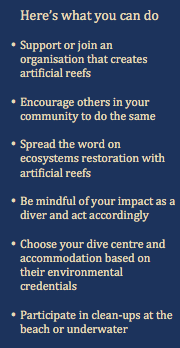
Related Sustainable Solutions

Restoring Mangroves (VCT)
On Union Island, mangrove restoration has led to increased biodiversity, better coastal protection, and more economic activity.

Wildlife Rescue (SUR)
In Suriname, we meet an organization that rescues wildlife. How does that also help our own survival?

Sea Forests (NAM)
In South Africa and Namibia, we learn about the importance of current and future sea forests. How can they help humanity become more sustainable?

Coral Gardening (PYF)
In French Polynesia we see the beauty of coral reefs, but these important ecosystems are under threat. Fortunately, it’s not too late to save them.

Shark Protection (PYF)
French Polynesia is saving sharks with the largest shark sanctuary in the world. These top predators are vital in keeping reefs and oceans healthy.

A Farm That Restores Nature (CHL)
The Chilean farm Alihuen combines organic farming and tourist education to restore local flora and fauna on former grasslands.

Cleverly Fighting Plastic Pollution (CHL)
Chilean company Algramo uses clever, reusable packaging to reduce plastic waste and save customers money.

Investing in Nature (CHL)
Chilean Patagonia thanks its pristine wilderness to successful conservation efforts. Among them Tompkins Conservation, a remarkable, private initiative.

Artificial Reefs (CPV)
In Cape Verde and Brazil we learn how man-made structures can help to restore underwater ecosystems.

Saving Sea Turtles (CPV)
On the Cape Verdian island of Sal, we meet an organisation that saves sea turtles. We learn how biodiversity can be increased and damaged ecosystems restored while working together with the tourism industry.

Rewilding (GRC)
On the Greek island of Kalamos, we learn about rewilding. We are inspired by the way this form of ecosystem regeneration balances natural and human needs.

Reforestation on Steroids (ITA)
Reforestation helps to fight climate change, drought and fires. Innovations like the COCOON support young trees and accelerate the creation of new forests.

Creative with Cork (PRT)
In Portugal we learn all about the environmental and social sustainability aspects of cork. Time to get more creative with this remarkable natural material!
